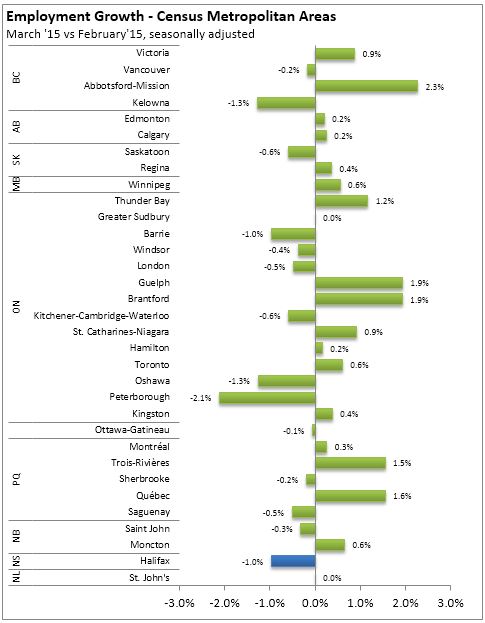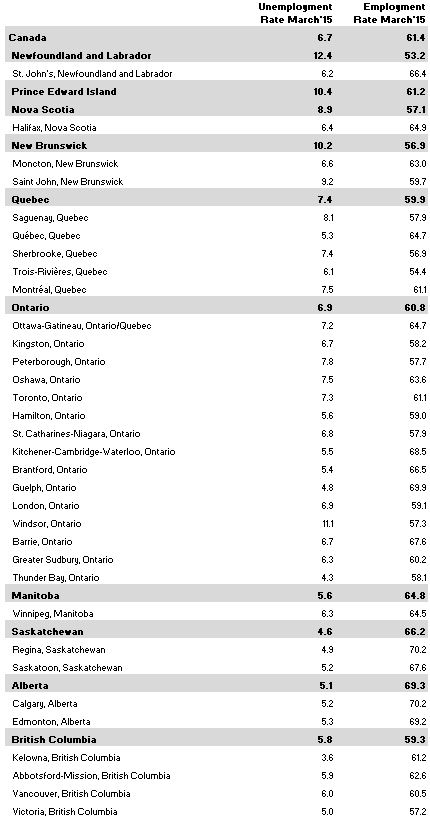April 10, 2015LABOUR MARKET TRENDS - MARCH 2015 TRENDS
Nova Scotia's seasonally adjusted employment decreased by 500 in March, 2015. This follows a loss of 4,400 jobs in February and a loss of 100 jobs in January. Except for February, the labour force survey has reported largely insignificant changes to employment in the last five months.
Compared to February, the labour force has increased by 600 to 491,800 moving away from the trend of declining labour force since the beginning of 2013.With labour demand decreasing, coupled with an increasing labour force, the net result was a 0.2 percentage point increase in the seasonally adjusted unemployment rate, reaching 9.3 percent in March. With a slight increase in the labour supply, the participation rate increases by 0.1 percentage points to 62.7 per cent. The slight drop in labour demand resulted in no change in the employment rate at 56.9 per cent.
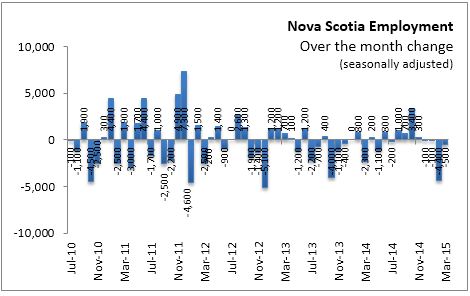
In March, full-time employment decreased by 5,800 jobs while part-time employment increased by 5,400 jobs. These results return to the long-standing trend of offsetting employment changes between full and part time work. Back and forth changes in hours offered by employers (ie: shifting employment into and out of part time status) has been a persistent phenomenon since the recession.
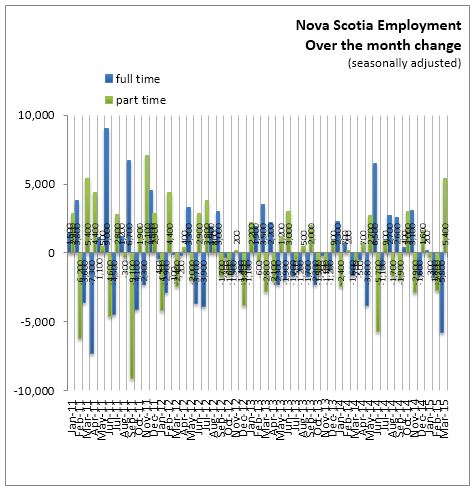
Compared with March 2014, the labour force has increased by 1,700 (0.3 per cent) while there were no changes in the total employment level. The drop of 900 in part time jobs is matched by a gain of 900 full time jobs. With no changes in the employment combined with an increase in the labour supply, the net result was a 0.3 percentage point increase in seasonally adjusted unemployment rate.
Year-to-date
For the first quarter of 2015 compared to the first quarter of 2014, there was an increase of 500 jobs (0.1 per cent) in the average employment level. Average full time employment was up 4,500 while there were 4,000 fewer part time workers. The labour force had an increase of 500 for the first quarter of 2015. With matching increases in labour supply and demand, the net result was no change in the average unemployment rate at 8.9 per cent. The labour force participation rate dropped 0.1 percentage points to 62.7 per cent. The employment rate fell by 0.1 percentage points to 57.1 per cent.
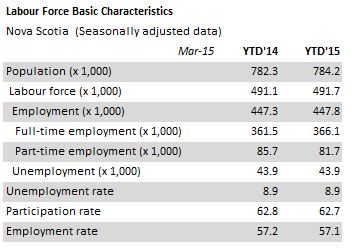
Comparing the year to date employment change by class of worker, the first quarter of 2015 saw an increase of 1,500 including employees and self-employed. Self-employment is down 1,000 persons year to date and private sector employment also declined by 1,000 persons. Employment in the public sector was up by 2,500 the main source of the net gain for employees. Public sector employment is still far below the levels of late 2011 and early 2012.
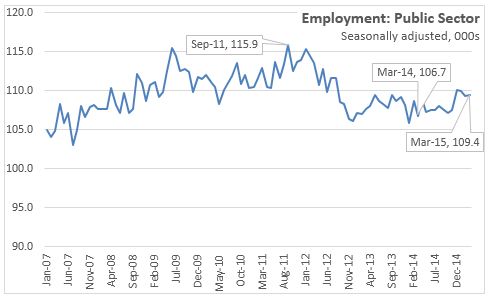
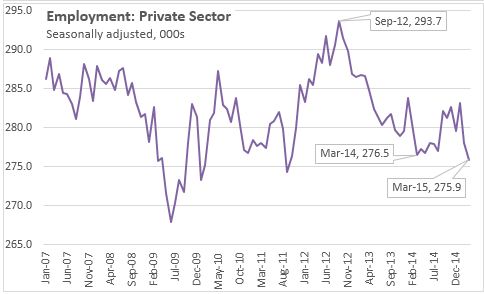
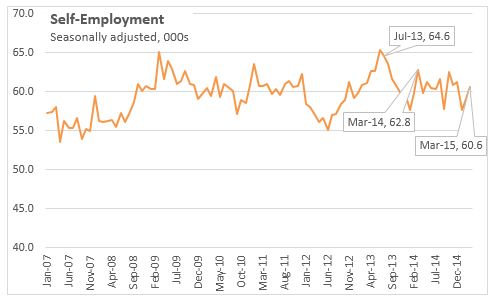
SECTORS
Comparing the first quarter of 2015 to the first quarter of 2014, employment in goods-producing sectors fell by 6,100 jobs. There were declines reported in all goods sectors except primary production. There was a net gain in employment of 6,500 in service-producing sectors. There were only declines in trade (retail and wholesale) and other services.
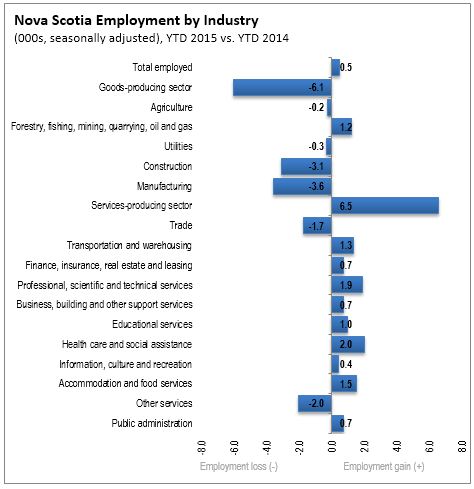
REGIONS (three month moving average unadjusted)
Halifax (HRM), Cape Breton and the South Shore region reported increases in employment among the province's five economic regions comparing the first quarter of 2015 over the same period in 2014. The same three regions also reported labour supply increases. Unemployment rates were down in four economic regions (Cape Breton, South Shore, Valley and HRM), with an increase in the North Shore region
The Cape Breton region reported an increase of 1,300 jobs comparing the first quarter of 2015 to the same period in 2014. The labour force increased by 1,400 jobs for the same period. With labour supply growing at a similar pace with labour demand, the net result was a decrease of 0.3 percentage points in the unemployment rate to 15.4
For the North Shore region, employment decreased 3,600 for the first quarter of 2015 over the first quarter of 2014. Labour supply fell by 2,800 for the same period. The larger fall in labour demand caused a 1.6 percentage point increase in the unemployment rate to 12.4 per cent.
The Annapolis region experienced a drop of 2,500 in employment while the labour force had a fall of 3,700 for the first quarter 2015 over the same period in 2014. The net result was a 1.5 percentage point decrease in the average unemployment rate to 8.9 per cent.
The Southern region saw employment increase by 2,000 and the labour force decrease by 700 for the first quarter of 2015. With the labour demand increasing at a faster pace, the end result was a drop in the unemployment rate of 2.5 percentage points to 11.0 per cent.
For the first quarter of 2015 compared to the first quarter of 2014, Halifax (HRM) experienced an increase in employment (5,100) plus an increase of 4,800 in the labour supply. With a faster pace in labour market demand, the net impact was 0.2 percentage point drop in the unemployment rate to 6.4 per cent.
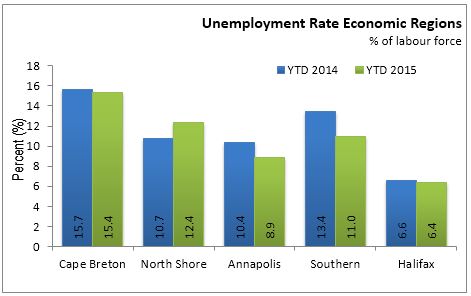
PROVINCIAL COMPARISONS
Year to date employment (average) across the country averaged 0.7 per cent growth in March 2015 compared to March 2014. Leading the country at 2.2 per cent growth is Alberta, followed by Manitoba at 2.1 per cent. Compared to the first three months of last year, three provinces showed declines (Newfoundland and Labrador at -2.3 per cent, PEI at -0.1 per cent, New Brunswick at -0.9 per cent). Nova Scotia showed slight growth at 0.1 per cent compared to last year.
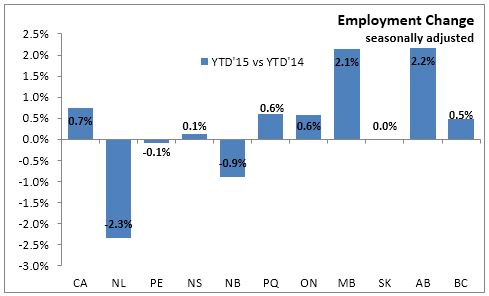
Comparing unemployment rates this month to those a year ago, Nova Scotia showed an increase to 9.3 per cent in March 2015. Five provinces showed declines in the Unemployment Rate in March 2015, the largest decline in Ontario, whose rate fell by 0.4 percentage points to 6.9 per cent.
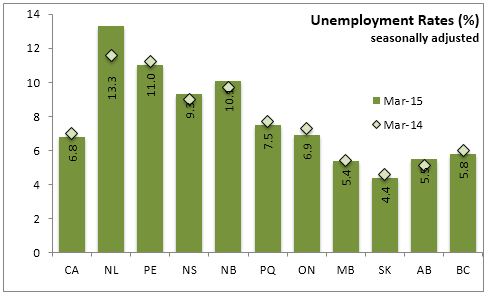
National Comparisons: Cities
The seasonally adjusted unemployment rate for the Halifax Census Metropolitan Area was 6.4 per cent. Kelowna (3.6%) had the lowest unemployment rate in Canada this month.
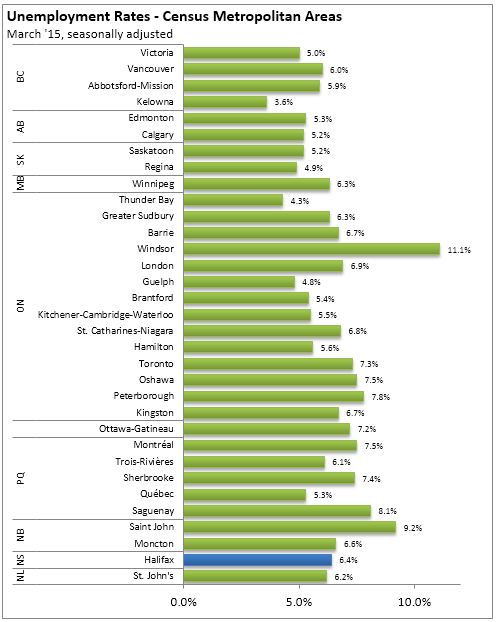
The seasonally adjusted employment rate for the Halifax Census Metropolitan Area dipped slightly to 64.9 per cent in March 2015.
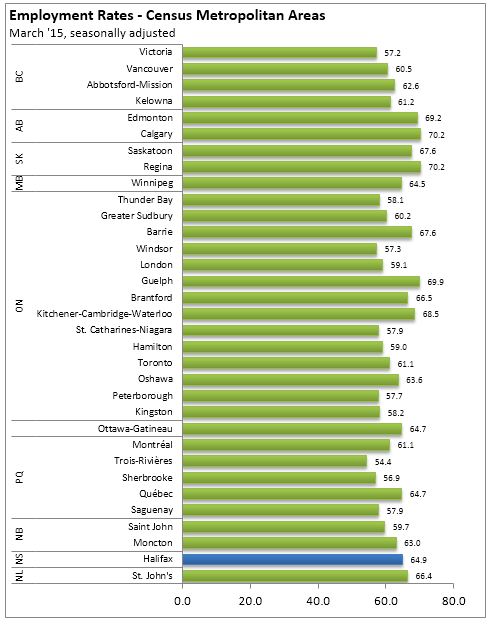
Employment in the Halifax CMA was down 1.0 per cent from February, in March 2015. The largest gain from month to month in CMAs was in Abbotsford-Mission, BC, which rose by 2.3 per cent over the previous month.
